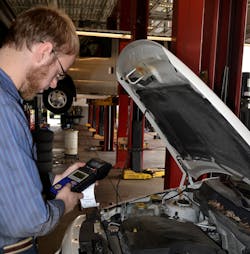Let’s look at pay plans from an historical perspective first, and then look at what’s going to work from a business view.
Historically, technician pay plans have ebbed and flowed on popularity, with one end tugging on the business side of profitability. At the other end are technicians who want to get paid like professionals.
Hourly, salary, flat rate, or combo plans. Rinse repeat. When flat rate was at its peak popularity, technicians were getting paid close to twice as much time as it took to do a job with the right tools, the right way. Then new car dealerships started cutting hours to get more competitive with the aftermarket, and then the aftermarket started adjusting flat rate time as well.
The technician has taken the brunt of the cuts for the last two or so decades, right in the wallet. This has led many technicians to complain about flat rate. What they are complaining about though, is the lack of pay in their pocket.
If a technician at Indy Pendant Tire & Auto makes $30/hour flat rate, and is 75% productive to his 50-hour work week, he’s taking home 37.5 paid hours @ $30, no overtime (let’s stick to federal law). That’s $58,500 a year. That’s on par with non-union electricians, plumbers, etc. But techs have thousands of dollars in tools they must buy, and that’s a big difference.But here’s the rub: If the tech is unhappy at $30/hour flat rate, the shop isn’t going to convert them to $30/hour salary or hourly. The rate will drop. Because it has to drop.
You see, the average shop in North America is right about $100/hour labor or “door” rate. (As a side note, if you are below that, you are damaging the industry, and holding back every other owner and technician this side of the hemisphere. Stop charging 1990’s door rate and get with the times! No more, “You don’t get my situation/town/clientele/whatever” excuse. Just stop it. Stop! Tire stores that don’t get their door rate to $100 right now are dinosaurs and the meteor is coming. End of rant.)
Let’s get back to the stores at or above $100/hour. The average shop can only pay a top technician $30/hour because the $100/hour door rate is handicapping them. Simple financials dictate technicians earn 30% of door rate by productivity.
So the tech who wants to bail on flat rate, which rewards hustle (and, to be fair, really hurts the tech on a down month, something over which a tech has no control) goes to salary or hourly at a much lower rate, because the shop must factor in down time.
Essentially, the tech will still earn about $60,000 a year, because that’s what the shop will bear.
So what to do? Hmm, let me think. This is a tough one. You should raise… your... labor… rate.
Simple financials dictate
technicians earn 30% of
door rate by productivity.
Let’s count the ways it’s important to start this journey now.
1. Impending talent crunch, when tech compensation is going to skyrocket.
2. Already crushing housing cost burden in major cities (I’m looking at you, East Coast and West Coast).
3. Complexity of vehicle repairs.
4. Cost of training.
5. Equipment upkeep/update costs.
6. New equipment that didn’t exist 10 years ago.
7. Digital everything.
All of this costs money. And if, as an independent dealer, you are going to cling to 1997’s labor rate because you believe “no one understands my unique situation, why I have to stay under $100,” then you are a ghost. And eventually will be gone. You will not have any technicians who will work for you, you won’t’ have any money to keep up your business — and you will have no one to sell the business to when you finally give up.
Once again, raise your labor rates.
Technicians should be paid handsomely for the hard physical and mental work they do, and the investment they make in their tools. Shouldn’t they make more than the average Walmart truck driver, who makes $72,000? The only way to do this is to charge more so you can pay more.
“But people will show up with pitchforks and torches if I raise my labor rate,” you say. “They will salt my land and burn down my barn.”
No, they won’t. We tend to get way too focused on the vocal few who complain. Out of the 500 or so customers you see each month, how many have an absolute meltdown on price?
And I have more news for you. If they are complaining at $100/hour, then they will complain at $95, at $90, at $80… at $75. Why should a handful of customers dictate to a business how much it should pay its employees? Why do a vocal few get to restrict re-investment in a business? They shouldn’t. And shame on you if you let them.
How do you get modern about your labor rate? First, start making routine increases at least twice a year, say, $2 to $4 an hour every few months. If you go from $75/hour to $120/hour all at once, then you might see pitchforks and torches. That’s a huge leap all at once. But if you are way behind, bump the rate up $10 an hour to start, and then a few dollars every four to six months.
Second, reward productive employees. Now is not the time to go crazy, but if a very good employee is long overdue for a raise, give a gesture that shows you want to operate your business in the 21st century. Also, always keep that “30% of the labor rate” profitability rule in mind though. If you go to $110/hour, the highest paid person is still capped at 30%, or $33 (productive).
Third, stop quoting jobs by the hour and beating it into your customer’s heads how much you charge an hour. If you are afraid to raise your labor rate, I promise you your salespeople say things all day long like, “Well, it’s going to take the technician two hours to do the job, which is $200, and the parts are $150.” Or some version of that.
Please make that stop. Customers only care about total price. Every time a salesperson mentions a number, it invites an objection by the customer. I suggest you give the price once: “The technician can have your car fixed by the end of the day, and it will only cost $350.”
So, what are you waiting for? Change your rate, set an automatic update in Outlook or Gmail, figure out who deserves a raise, and stop quoting every little charge. You can thank me later. ■


